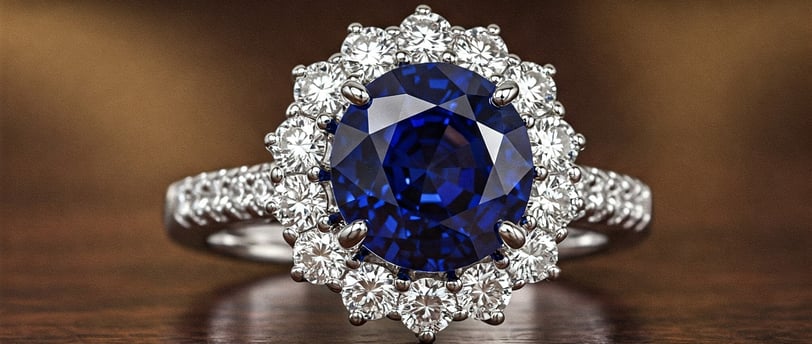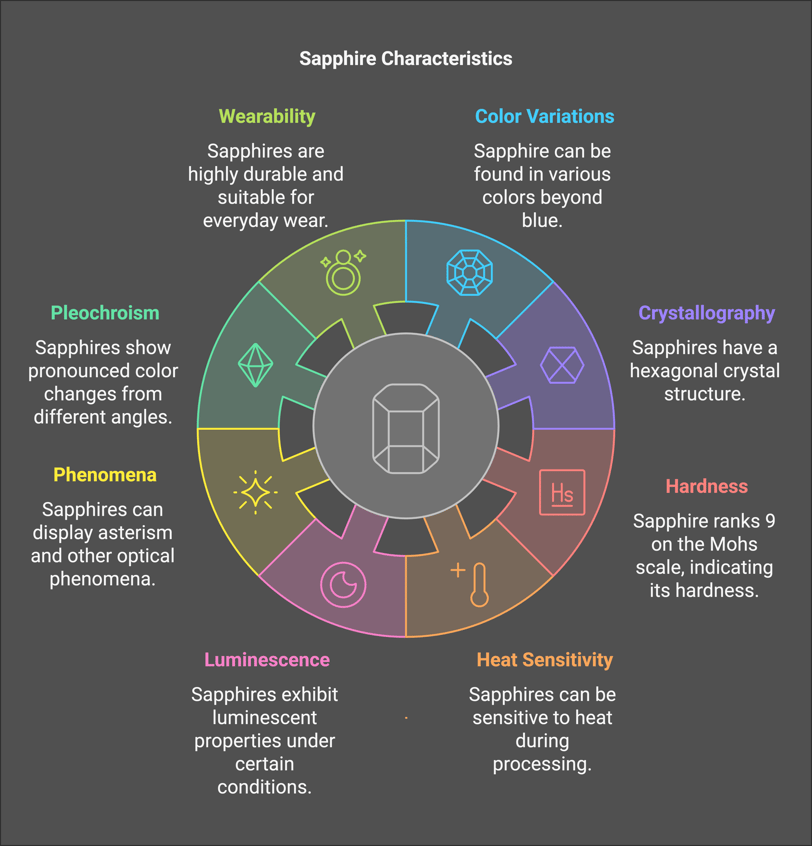Sapphire
Sapphires: A World of Colour and Durability. Discover the captivating beauty and exceptional qualities of sapphires, from their rich history to their wide range of colours and their suitability for everyday wear.
1/30/20255 min read


History
Sapphires, with their rich history and association with royalty, are among the most popular and expensive gems in the world. The name "sapphire" itself comes from the Latin word "sapphirus," meaning blue. For centuries, sapphires have been thought to protect against poison and fraud, and star sapphires were believed to have the power to divine the future. Ancient references to sapphires may actually refer to lapis lazuli. The gift of a sapphire symbolises a pledge of trust, loyalty and sincerity. This makes them a popular choice for engagement rings. Sapphires are also the birthstone for September and the gem of the 5th and 45th anniversaries.
Mineral Origins
Sapphires are a variety of the mineral corundum. Gem-quality corundum falls into two categories: ruby and sapphire. All red corundum is considered ruby, while all other colors are considered sapphire. This means sapphires occur in every color except red. Sapphires are found all over the world, and the specific combinations of trace minerals found at their sources lead to subtle variations in color. The host rock type often determines the color of a sapphire. For example, sapphires from non-basaltic rock, such as marble or limestone, typically have more brilliant hues. On the other hand, basaltic rocks, which contain high amounts of iron, tend to produce sapphires with darker colours. Sapphires can be found in metamorphosed crystalline limestones and dolomites, as well as in other metamorphic rock types, such as gneiss and schist. They can also be found in igneous rocks, such as granite and nepheline syenite. Well-known sources of sapphire include Myanmar, Cambodia, Thailand, Laos, Vietnam, Sri Lanka, and Kashmir in Asia, as well as Kenya, Tanzania, Nigeria, Madagascar, and Ethiopia in Africa. Australia and the United States, particularly Montana, also boast sizable deposits.
The 4 C’s
When assessing the quality of a sapphire, the four Cs—color, clarity, carat, and cut—are key.
Color
Color is the most important factor in determining the value of a sapphire. Blue sapphires are often the most highly valued. However, sapphires come in a wide range of colors, including pink, orange, yellow, green, purple, and violet. These are known as "fancy sapphires". The most desirable blue sapphires are velvety blue to violetish blue, with medium to medium-dark tones and strong to vivid color saturation. The saturation should be as strong as possible without darkening the color and compromising brightness. The basic hues include red, orange, yellow, green, blue, violet, and purple. Tone refers to a colour's relative lightness, from colourless (0) to black (10), and saturation refers to a colour's intensity, from grayish or brownish (1) to vivid (6). Kashmir sapphires, known for their "cornflower" blue, set the color standard for sapphires. Burmese sapphires have a "royal" blue with greater saturation. Sri Lankan sapphires have the same hue as Kashmir and Burmese stones but tend to have weaker saturation and lighter tones. Montana sapphires are typically pale or steely blue-gray. Some sapphires exhibit a colour change, typically from blue or violet in daylight to violetish purple or reddish purple in incandescent light. Padparadscha sapphires are especially prized and display pink-orange hues.
Clarity
Sapphires are Type II gems, meaning they usually contain inclusions. Inclusions are fractures and materials such as liquids, gases, and even crystals of other minerals inside their structure. These inclusions may be long, thin mineral inclusions called needles, or intersecting groups of rutile called "silk". Kashmir sapphires are known for their velvety appearance caused by fine threads of rutile crystals that scatter light. The clarity of a sapphire is graded based on the visibility of inclusions. Top tier clarity sapphires are graded VVS (very very small inclusions) or "loupe clean", with no inclusions visible under a 10X loupe. The second tier includes VS (very small inclusions) and SI (small inclusions), where inclusions may or may not be visible to the naked eye. The third tier includes stones graded SI to I (included), which are not eye-clean.
Carat
The price per carat of sapphires increases gradually at sizes of two, three, and four carats. Sapphires over five carats are rare and will see a jump in price per carat. Blue sapphires can range in size from a few points to hundreds of carats. Large blue sapphires are more readily available than large rubies, with most commercial-quality blue sapphires weighing less than 5.00 carats.
Cut
The cut of a sapphire affects its value. Cuts that maximize light return, such as brilliant cuts, or enhance color, such as step cuts, are recommended. Emerald and marquise cuts add the most to a sapphire's value, followed by round and pear cuts. Common cuts include ovals and cushions. A cabochon cut can display asterism or the star effect. For star sapphires, the dome should be fairly high to focus the star sharply. Cutters focus on factors like color zoning, pleochroism, and the lightness or darkness of a crystal to best determine how to orient the gem during cutting.
Be Aware Of
Enhancements
Sapphires are commonly treated to enhance their color and clarity. Heat treatment is commonly used to remove rutile inclusions and improve color tone and saturation. Diffusion treatments are used to alter the color of sapphires by diffusing an element into the gemstone. Beryllium treatments have been used to turn light colored sapphires into padparadscha-like gems. It is important to ask about any treatments a sapphire has undergone, and to be aware that treated sapphires are generally less valuable than untreated ones.
Simulants
Due to the popularity of sapphires, other gemstones may be used to simulate their appearance. Blue tourmalines may be referred to as "Brazilian Sapphires," and yellow sapphires may be sold as "King's Topaz". These are different gem species, and professional gemologists can distinguish them using standard tests. Glass, plastic, and other synthetic materials may also be used as simulants.
Synthetics
Synthetic sapphires have the same chemical, physical, and optical properties as natural sapphires but are grown in a laboratory. Synthetic sapphires are much less expensive than natural ones. A key indicator of synthetic origin is the presence of curved striae within the stone, whereas natural sapphires will show angular lines. Synthetic sapphires may also exhibit extraordinarily vivid colouring, strong fluorescence, and high clarity.
Final Thoughts
Buying Tips
When purchasing a sapphire, it is important to work with a reputable jeweler and to understand the difference that color makes. Look at different colors of sapphire side by side to understand the range of qualities available. Do not compromise on cut, as the quality of the cut can make a big difference in beauty and brilliance. Always ask about any treatments the sapphire may have undergone. If you suspect a sapphire may be synthetic, have it appraised by an independent gemology lab. Be wary of sapphires with two names, as some vendors may attach the name "sapphire" to less expensive gemstones.
Jewelry Care
Sapphire is a durable stone and is great for everyday wear. To keep your sapphire beautiful, remove it at night. Clean it with warm soapy water and a soft brush. Most sapphires will withstand ultrasonic cleaning, but avoid steam. Fracture-filled, cavity-filled, or dyed material should only be cleaned with a damp cloth.


Gemius Stones
Expertise
© 2025. All rights reserved.
